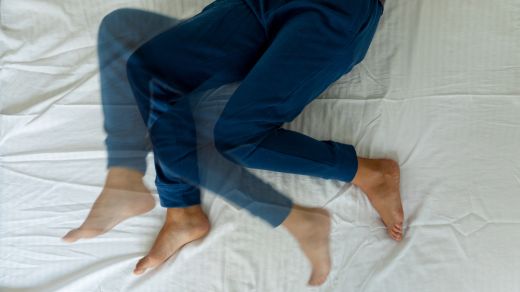Restless Legs Syndrome is a disease in which those affected suffer from restlessness and discomfort in the legs or arms. The symptoms occur mainly in the evening and at night. What causes are possible and what those affected can do!
- © Getty Images/bymuratdeniz
quick overview
Symptoms: urge to move the legs (especially when inactive) and discomfort; resulting insomnia and daytime sleepiness
Diagnosis: Anamnesis (description of the symptoms), neurological examinations, exclusion of other diseases
Treatment: good sleep hygiene, stretching exercises, massage, cold, medication (gabapentin, dopamine agonists, L-dopa)
Article content at a glance:
What is Restless Legs Syndrome?
Restless Legs Syndrome (RLS) means “restless legs syndrome” and is also known as Willis-Ekbom disease. It is a chronic neurological disease that is characterized by an unpleasant urge to move and can be accompanied by unpleasant sensations and even pain. Usually the legs are affected, more rarely other parts of the body such as the chest.
Frequency of RLS
Experts estimate that around 7 to 10 percent of the population in western industrialized countries are affected. RLS is about as common as migraines. The disease usually occurs in middle age, somewhat more frequently in women than in men.
Symptoms of Restless Legs Syndrome
Restless Legs Syndrome is primarily characterized by a strong urge to move the legs. One or both legs can be restless.
Other typical features of the RLS are:
Abnormal sensations such as tingling, pins and needles, burning or restlessness in the legs, arms or other parts of the body
Onset or worsening of symptoms during rest or inactivity, such as lying down or sitting
Relief of discomfort through exercise (running, walking or stretching) – at least for the duration of the activity
Sleep disorders due to increased nocturnal leg movement and the resulting tiredness and exhaustion during the day
At the beginning of the disease, the symptoms are usually only mild and there are always symptom-free phases. However, these decrease more and more over time and the alleviating effect of exercise also decreases as RLS progresses.
Above all, the sleep disorders associated with restless legs can severely impair the quality of life of patients and be psychologically stressful. In addition, some of those affected avoid sitting for long periods, for example in the cinema, theater or when travelling, which can lead to social isolation.
Difference to PLMD
People with PLMD (Periodic Limp Movement Disorder) also suffer from involuntary nocturnal limb movements. This usually occurs rhythmically every 30 seconds and can affect the quality of sleep. In contrast to Restless Legs Syndrome, those affected are often unaware of the phenomenon and cannot explain the causes of their constant tiredness.
Restless Legs Syndrome: What Causes Restless Legs?
The cause of restless legs often goes undetected. Experts then speak of idiopathic restless legs syndrome. What is certain is that a hereditary predisposition can be proven in some of those affected. If one parent has RLS, there is an increased risk that the children will also develop it. In addition, a disorder of the dopamine metabolism in the brain seems to play a role. This messenger substance is responsible, among other things, for controlling movements.
In some cases, however, RLS is also the result of another disease or only occurs under certain circumstances. Then there is talk of the so-called secondary or symptomatic Restless Legs Syndrome. Possible causes include:
In addition, taking medication such as neuroleptics or antidepressants can trigger or increase the urge to move the legs.
Does Restless Legs Syndrome also have psychological causes?
Whether restless legs syndrome can also have psychological causes has not been sufficiently clarified. A connection with anxiety disorders and depression was found. However, it is not known whether these are the cause or the consequence. However, chronic sleep disorders and the urge to move can severely impair the quality of life.
Diagnosis: How is Restless Legs Syndrome diagnosed?
The diagnosis of Restless Legs Syndrome is made primarily on the basis of the symptoms described. A detailed medical consultation is usually sufficient for this. The following criteria must be met for the diagnosis to be made:
strong urge to move the legs
Reinforcement during rest/inactivity
Relief of discomfort through exercise
Occurrence or aggravation in the evening or at night
Exclusion of other diseases (e.g. muscle cramps, leg edema, arthritis, myalgia) that resemble RLS and are referred to by experts as RLS mimics
Polysomnography can also be helpful. In this examination, which is usually carried out in a sleep laboratory, various bodily functions are recorded during sleep. Neurological examinations help to rule out other diseases such as nerve damage as a cause. Even if patients respond to treatment with drugs containing dopamine, this indicates Restless Legs Syndrome.
Treatment of Restless Legs Syndrome
Treatment for Restless Legs Syndrome depends on the cause and the severity of the symptoms. In the case of secondary RLS, an attempt is usually made first to treat the underlying disease. If an iron deficiency is determined, those affected receive preparations, for example, to compensate for the deficit.
Medication for RLS
Drug treatment is an option for idiopathic Restless Legs Syndrome, especially if those affected are suffering severely from the symptoms. The drugs of choice are so-called dopaminergic drugs, which include L-dopa and dopamine agonists. These are also used to treat Parkinson’s disease. The two diseases have nothing to do with each other.
Alternatively, treatment with gabapentin can also be carried out. However, according to the guideline, this is an off-label use. The active ingredient was originally developed to treat epilepsy. Pain relievers such as opioids are sometimes prescribed for leg pain.
augmentation
Drug therapy is not suitable for everyone. In some cases, they even lead to a worsening of the symptoms (augmentation). Increasing the dose does not make sense either. It is recommended to consult with the doctor to change the drug strategy and to discuss possible side effects.
Restless Legs Syndrome: home remedies and self-help
In addition, there are also some measures that those affected can take themselves to alleviate symptoms, for example:
Maintaining good sleep hygiene with regular bedtimes
moderate physical activity
Avoiding RLS enhancing factors such as alcohol, caffeine and nicotine
In acute cases, those affected often also help with light stretching exercises or massages. Cooling baths or compresses can be beneficial as home remedies.
Course of Restless Legs Syndrome
Restless Legs Syndrome progresses very differently in those affected. With secondary RLS, symptoms can also disappear completely if the underlying disease has been treated successfully.
If no cause is known, this is a little more difficult. Nevertheless, here too, appropriate measures can usually achieve a significant alleviation of the symptoms. Some sufferers, however, have to take medication for life. Many of those affected find self-help groups in which they can talk to each other about their illness to be helpful.



